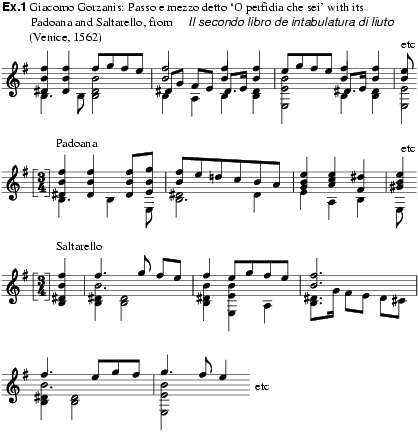
(It.: ‘Paduan’).
A term used in the 16th and 17th centuries for at least two kinds of dance. No choreography with the title ‘padoana’ is known to exist, but the title appears in several important lute and keyboard collections. In some 16th-century sources it seems to be equivalent to the dignified, duple-metre Pavan, as in J.A. Dalza's lutebook of 1508, Phalèses Des chansons reduictz en tabulature (1545) and Sebastian Vredeman's Carminum quae cythara (1569). In others, however, the title denotes the first triple-metre after-dance of a Passamezzo, as in Jean d'Estrée's Tiers livre de danseries (1559), where ‘La padouenne’ follows a ‘Pas meige’; and in the lutebooks of Giacomo Gorzanis there are several groups of dances in the order passamezzo–padoana ‘del ditto’–saltarello ‘del ditto’ (ex.1), based on the same melodic material. In the 17th century, particularly in Germany and the Netherlands, the term seems to have reverted to its earliest known meaning, as the equivalent of pavan (e.g. in Paul Peuerl's Newe Padouan, Intrada, Däntz unnd Galliarda, 1611, Schein's Banchetto musicale, 1617, and Isaac Posch's Musicalische Tafelfreudt, das ist Allerley neuer Paduanen und Gagliarden, 1621). The exact relationship, if any, between duple- and triple-metre padoanas is unknown.

BrownI
MGG1 (L. Moe)
R. Eitner: ‘Tänze des 15. bis 17. Jahrhunderts’, MMg, vii (1875), 100, 109–11
L.H. Moe: Dance Music in Printed Italian Lute Tablatures from 1507 to 1611 (diss., Harvard U., 1956)
TIM CRAWFORD